ESD floor runner material typically comes in standard roll lengths of 50 to 75 feet, with 60 feet being the most common option you'll find. You can get these runners in various widths including 24", 30", 36", and 48" to suit your workspace needs. If you need custom dimensions, suppliers offer professional cutting services for rolls up to 75 feet long and 4 feet wide. Pre-cut mats are also available in smaller sizes like 36" x 60" and 36" x 72" for more compact areas. There's much more to take into account when selecting the right ESD runner dimensions for your facility's protection requirements.
Standard Roll Length Options

The roll length you choose should align with your facility's layout and ESD protection needs.
Standard ESD floor runner material comes in 4 feet by 60 feet dimensions for optimal coverage.
Each standard length option complies with ANSI/ESD S20.20 guidelines, ensuring consistent ESD performance throughout your installation.
Whether you're using vinyl or rubber materials, you'll find that these standardized lengths work effectively for both conductive and dissipative applications, providing reliable ESD protection in your workspace. The material features a solid flat surface that resists damage from chair casters while maintaining its protective properties.
Custom Size Availability
You'll find ESD floor runners can be custom-cut to your exact specifications, with widths up to 4 feet and lengths extending to 75 feet.
The factory provides professional cutting services to guarantee precise dimensions for your specific workspace requirements. Roll sizes are readily available to accommodate both small workstations and large facility installations. Permanent conductivity ensures reliable static protection throughout the life of the material.
If you prefer to handle the cutting yourself, you can easily trim full rolls using a sharp box cutter and straight edge to achieve your desired measurements.
Made-to-Order Runner Options
When it comes to ESD floor runners, made-to-order options provide extensive flexibility in sizing and configurations. You'll find manufacturers ready to customize your ESD matting from standard 50' or 60' rolls, with the ability to specify exact dimensions for your workspace. These mats must maintain resistance under 10^9 ohms to ensure proper static dissipation. With free shipping over $100, many facilities find it cost-effective to order custom-length runners for their specific needs.
Whether you need vinyl or rubber materials, you can get your runners cut to precise measurements with grounding hardware pre-installed.
Different material compositions let you tailor your ESD protection to specific requirements. You can choose from single-layer, 2-layer, or 3-layer constructions, each offering unique benefits for your application.
Leading manufacturers like VinylSTAT, Ergomat, and NoTrax will work with you to create custom solutions that fit your exact specifications.
- Request pre-cut mats with installed grounding hardware for immediate use
- Select from various material thicknesses and textures to match your needs
- Combine different layers for ideal ESD performance and comfort
- Choose between vinyl for easy cutting or rubber for chemical resistance
You'll find suppliers can accommodate virtually any dimensional requirement, ensuring your ESD floor runners perfectly fit your workstations, production lines, or facility layout while maintaining proper static discharge protection.
Factory Cutting Services
Leading manufacturers provide three core factory cutting services to deliver precisely sized ESD floor runners that match your workspace requirements. You'll get precise cuts from full 50' rolls, custom dimensioning for specific applications, and specialty shape cutting for unique workspace layouts.
When you're planning your ESD floor protection, you can choose from various cutting options that uphold compliance with ANSI/ESD S20.20 standards while meeting your specific needs. The static dissipative properties help prevent billions in potential electronics damage. The factory cutting services accommodate both small mats and long runners, with multiple material thicknesses available. Our experienced customer service team provides expert guidance throughout the custom sizing process.
| Service Type | Specifications |
|---|---|
| Standard Cuts | 24"x48", 36"x48", 48"x72" |
| Custom Lengths | Up to 50' from full rolls |
| Material Options | Vinyl (0.090") or Rubber (1/2" – 5/8") |
| Color Choices | Black and Gray available |
| Turnaround Time | Rapid processing for custom orders |
You'll benefit from high-volume production capabilities and rigorous quality control measures that guarantee consistent performance. Each custom-cut piece includes appropriate grounding hardware and maintains the material's static dissipative properties, making it ideal for electronics assembly areas and other ESD-sensitive environments.
Most Popular Runner Dimensions
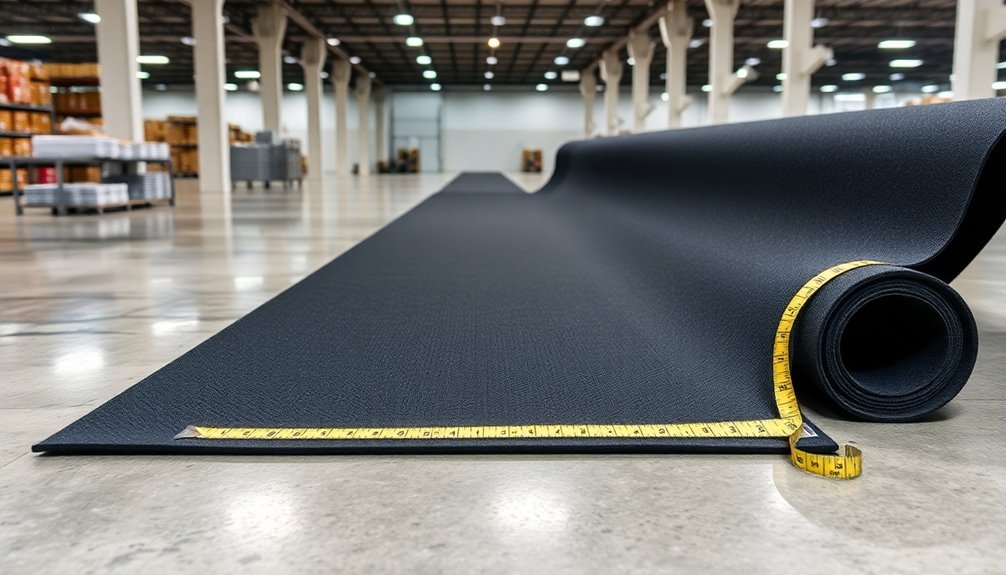
When you're selecting an ESD floor runner, you'll find that standard roll lengths typically range from 50' to 75', with 60' being a popular choice among facilities.
Common width options include 24", 36", and 48", allowing you to match the runner dimensions to your specific walkway or workspace requirements.
Pre-cut mat sizes offer more flexibility for smaller areas, though the most frequently purchased runners come in 4' widths with lengths between 50' and 75'.
Standard Roll Lengths
ESD floor runners come in several standard roll lengths to accommodate various workspace configurations. You'll find that most manufacturers offer both 50-foot and 75-foot rolls as their primary options, with the ability to customize lengths by cutting these standard sizes to match your specific needs.
For quick reference, here are the most common roll length options you can choose from:
- 50-foot rolls – ideal for smaller workspaces and shorter aisles
- 75-foot rolls – perfect for large areas and extended aisleways
- 72-inch precut mats – designed for standard workstations
- 48-inch precut mats – suited for individual work areas
You can easily adapt these standard lengths to fit your facility's requirements. If you're working with unusual floor configurations or have specific coverage needs, manufacturers can accommodate custom length orders.
The longer rolls are particularly versatile, as they can be cut on-site to create custom layouts for both aisleways and workbench areas. This flexibility allows you to maximize coverage while minimizing waste, ensuring you get the most efficient use of your ESD floor runner material.
Common Width Options
Popular width options for floor runners typically range from 24 to 48 inches, giving you flexibility to match your specific workspace requirements.
You'll find standard widths of 24", 30", and 36", with 48" (4-foot) being one of the most common choices for larger areas and aisleways.
When selecting your runner width, you'll need to take into account the space you're covering and its intended use.
For standard walkways and workstation areas, 36-inch runners often provide adequate coverage while maintaining efficient space utilization.
If you're planning to cover wider aisles or create larger protected zones, 48-inch runners are ideal and can be particularly effective when combined with longer lengths up to 75 feet.
You can also customize your coverage by installing multiple runners side by side using interlocking sections.
While some pre-cut mats come in specific dimensions like 3' x 12' or 4' x 6', you'll find the most versatility in ordering from standard rolls that can be cut to your exact specifications.
These rolls typically come in 50' or 60' lengths, allowing you to create runners that perfectly fit your facility's layout.
Pre-Cut Mat Sizes
Building on standard width options, manufacturers offer several pre-cut mat sizes to meet diverse facility needs. You'll find that most suppliers stock common dimensions that work well for both individual workstations and longer runner applications.
These pre-cut options help you avoid unnecessary waste while ensuring proper coverage for your ESD-protected areas.
The most popular pre-cut dimensions include:
- 36" x 60" – Perfect for single workstation protection
- 36" x 72" – Ideal for larger individual work areas
- 4' x 6' – Suitable for shared workspaces or small aisleways
- 4' x 60' – Standard roll size for longer continuous coverage
You can easily trim these pre-cut sizes to fit your specific requirements using basic tools like utility knives or box cutters.
If you need custom dimensions, many suppliers offer special cutting services or bulk ordering options. The cutting process won't affect the mat's ESD properties, so you're free to modify the size as needed.
For extended coverage requirements, you might want to contemplate the 75' continuous rolls, which provide maximum flexibility for large-scale installations.
Workbench Runner Specifications
Standard workbench runners provide reliable ESD protection while offering versatile sizing options to fit your workspace needs. You'll find these runners typically available in rolls of 50' or 60' lengths, which you can easily cut to match your specific workbench dimensions. The material thickness varies depending on your application requirements, with common options ranging from 0.060 inches to 0.090 inches.
When selecting your workbench runner, you'll need to take into account both the width and electrical properties. Standard widths are available in several sizes, and you can choose the most appropriate one based on your workspace layout.
| Width (inches) | Common Applications | Material Options |
|---|---|---|
| 24" | Small workstations | Vinyl, Rubber |
| 30" | Medium benches | Vinyl, Dual-layer |
| 36" | Standard benches | Rubber, Vinyl |
| 48" | Large workspaces | Dual-layer, Rubber |
For maximum ESD protection, verify your selected runner meets the required surface resistance specifications of less than 10^9 ohms. You can choose between conductive materials (less than 1 x 10^5 ohms/square) or dissipative materials (1 x 10^5 to 1 x 10^11 ohms/square) based on your specific ESD control needs.
Industrial Runner Length Guidelines
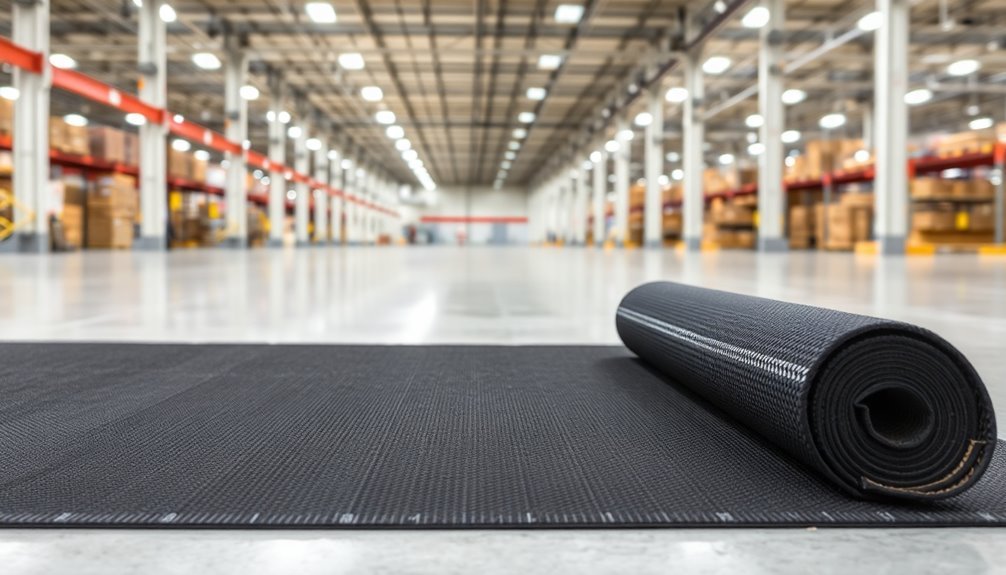
In accordance with industry standards, industrial ESD floor runners come in 50' or 60' roll lengths to accommodate diverse facility requirements.
You'll find these runners available in various widths including 24", 30", 36", and 48", giving you flexibility for different workspace configurations.
When you're planning your ESD floor protection, consider these essential aspects of industrial runners:
- You can purchase full rolls for future expansion or request custom-cut lengths that match your specific workspace dimensions, using a sharp utility knife for precise sizing.
- You'll need to select the right material type (vinyl or rubber) based on your monitoring requirements and verify it meets industry-specific resistance standards.
- You must properly ground each runner using appropriate hardware, which you can order with your purchase or acquire separately.
- You should factor in the runner's composition, as single-layer, 2-layer, or 3-layer options affect both durability and static control performance.
For ideal protection, you'll want to match your runner selection to your application needs while verifying compliance with relevant ESD standards like ANSI/ESD S20.20 and ASTM F1700.
Regular maintenance with neutral cleaners will help maintain the runner's ESD properties throughout its service life.
Material Thickness By Length
The thickness of ESD floor runners directly correlates with their available lengths and intended applications. You'll find thinner materials, like 0.060" and 0.090" runners, typically come in 50' rolls, making them ideal for general floor protection needs.
For higher traffic areas, you can opt for 1/8" (0.125") thickness, available in both 50' and 60' rolls.
When you're selecting material thickness, keep in mind that thicker options provide enhanced durability but may influence your length choices. You'll notice that most manufacturers maintain a thickness tolerance of ±10%, which guarantees consistent performance across the material.
If you need specific sizes, you can choose from pre-cut options like 4' x 6' mats or request custom lengths cut from full rolls.
You can easily identify the right combination of thickness and length based on your application requirements. For instance, if you're covering a high-traffic area, you'll want to take into account the 1/8" thickness, while general-purpose applications might work well with 0.060" to 0.090" material.
All thicknesses maintain their electrical performance regardless of length when properly grounded.
Facility Coverage Requirements
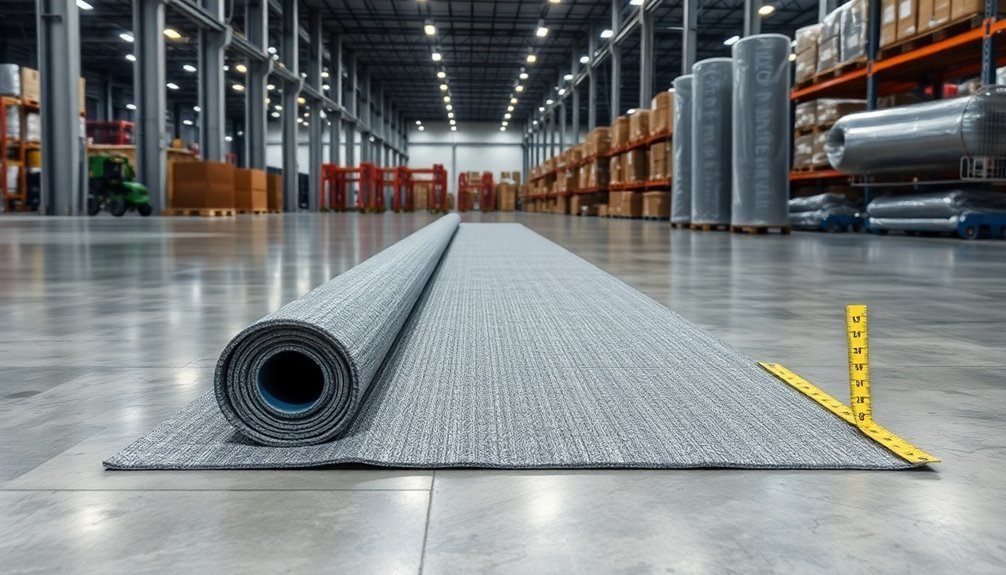
When planning your facility's ESD protection needs, you'll find a range of coverage options that start with standard 50' or 60' rolls available in widths of 24", 30", 36", and 48".
These materials are designed for easy cutting and customization to fit your specific requirements, whether you're outfitting an electronics assembly line or individual workstations.
For thorough facility coverage, consider these essential requirements:
- Choose between conductive and dissipative mats based on your static protection needs and constant monitor compatibility.
- Select appropriate materials for specific areas, such as anti-fatigue mats for standing workstations or fire-resistant options for areas with sparking equipment.
- Guarantee proper grounding installation throughout your facility to maintain effective ESD protection.
- Account for environmental factors like temperature and humidity when selecting your mat material.
You can opt for pre-cut mats with included grounding hardware for immediate implementation or create custom configurations using interlocking modular solutions.
Remember that your chosen materials should meet ANSI/ESD S20.20 standards while providing the necessary durability and chemical resistance for your specific application.
Proper installation and regular maintenance will guarantee long-term effectiveness of your ESD protection system.
Roll Storage Considerations
Proper storage of ESD floor runner materials requires careful attention to both environmental conditions and space utilization. You'll need to store your rolls in clean, dry areas to maintain their electrical properties and prevent damage.
Whether you choose to store them upright or flat, guarantee you're maximizing your available space while protecting the material's integrity.
Your ESD floor runners come in various dimensions, including 3' x 50' and 4' x 50' rolls, which you can customize by cutting to your specific needs. When handling the material, use a utility knife for basic cuts or opt for laser cutting when precision is essential.
Always handle the rolls by their edges to prevent scratches and maintain their protective properties.
You should consider your facility's environmental conditions when storing these materials. The runners are built to withstand UV exposure, chemical spills, and varying humidity levels while maintaining their static control properties.
With surface resistance ranging from 10^3 to 10^6 Ohms, these materials comply with ANSI/ESD S20.20 standards. Whether you're storing 1/8" or 3/32" thickness rolls, keeping them in proper conditions will guarantee they maintain their ESD protection capabilities.
Grounding Kit Length Requirements
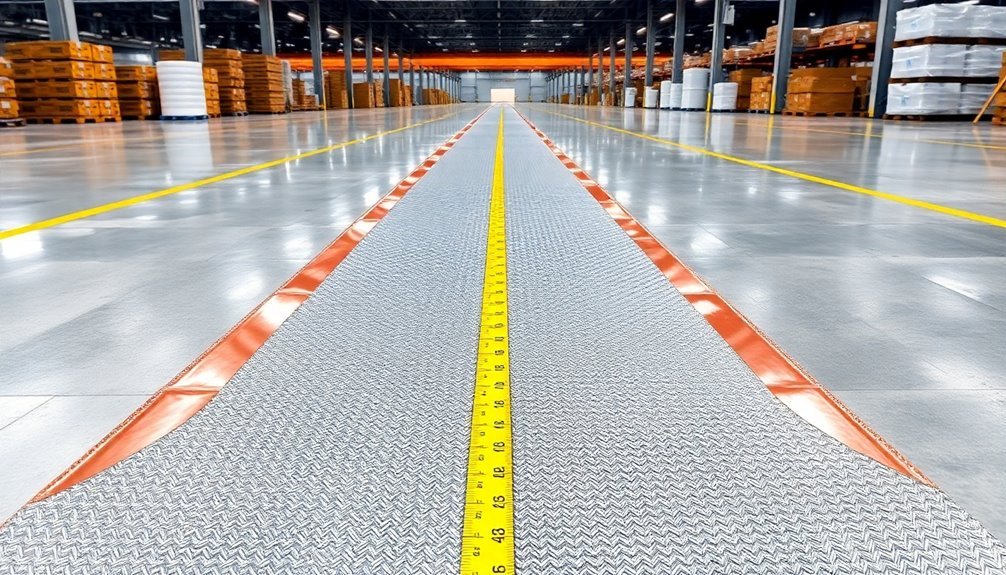
Carefully selecting appropriate grounding kit lengths guarantees ideal ESD protection for your facility.
When choosing your ESD floor runner material, you'll need to take into account both standard lengths and custom options to guarantee proper grounding coverage throughout your workspace.
Standard rolls typically come in 50' lengths with 3' or 4' widths, while floor runners extend to 75' with a 48" width. You can easily cut these materials to fit your specific needs using a utility knife, and you'll want to confirm each section includes proper grounding connections.
For best ESD protection, you should follow these key length-related requirements:
- Install grounding snaps at appropriate intervals on longer runs to maintain consistent conductivity
- Verify your grounding cord reaches the nearest ground point without strain
- Position heel grounders within easy reach of workstations
- Leave sufficient material length for die-cut lips under desks when using VinylSTAT FM7 mats
Remember that all conductive flooring must maintain secure grounding connections regardless of length.
You'll need to regularly check surface resistance readings and clean your runners with neutral cleaners to preserve their conductive properties across their entire length.
Frequently Asked Questions
Can ESD Runners Be Cut to Size Without Compromising Their Conductive Properties?
Yes, you can safely cut ESD runners to your desired size using a utility knife or laser cutting without compromising their conductive properties. The material's electrical performance remains permanent and effective regardless of cutting modifications.
What Is the Maximum Temperature Rating for Different Lengths of ESD Runners?
You'll find that ESD runner temperature ratings don't vary by length. While specific ratings aren't commonly listed, they're generally heat-resistant. Check your manufacturer's specifications for exact temperature limits for your material type.
How Often Should ESD Floor Runners Be Cleaned to Maintain Effectiveness?
You'll need to clean your ESD floor runners regularly, but there's no strict frequency specified. Clean them whenever you notice debris or dirt buildup to maintain proper grounding and ESD protection effectiveness.
Do Different Runner Lengths Require Different Maintenance Schedules for Optimal Performance?
No, you'll find that runner length doesn't affect maintenance schedules. You should clean and inspect your ESD runners regularly, regardless of their size. The same maintenance routine applies to all lengths for peak performance.
What Is the Expected Lifespan of ESD Runners Under Heavy Foot Traffic?
You'll typically get 5-7 years from your ESD runners under heavy foot traffic, though this can extend to 10 years with proper maintenance. Regular cleaning and following recommended maintenance schedules greatly impacts longevity.
In Summary
You'll find ESD floor runner material typically comes in standard 50-foot and 100-foot rolls, though custom lengths are available for your specific needs. When choosing your runner length, consider your facility's layout and grounding requirements. Don't forget to account for proper storage space and material thickness, which can affect roll diameter. For workbench applications, you'll want to measure your exact needs before ordering.

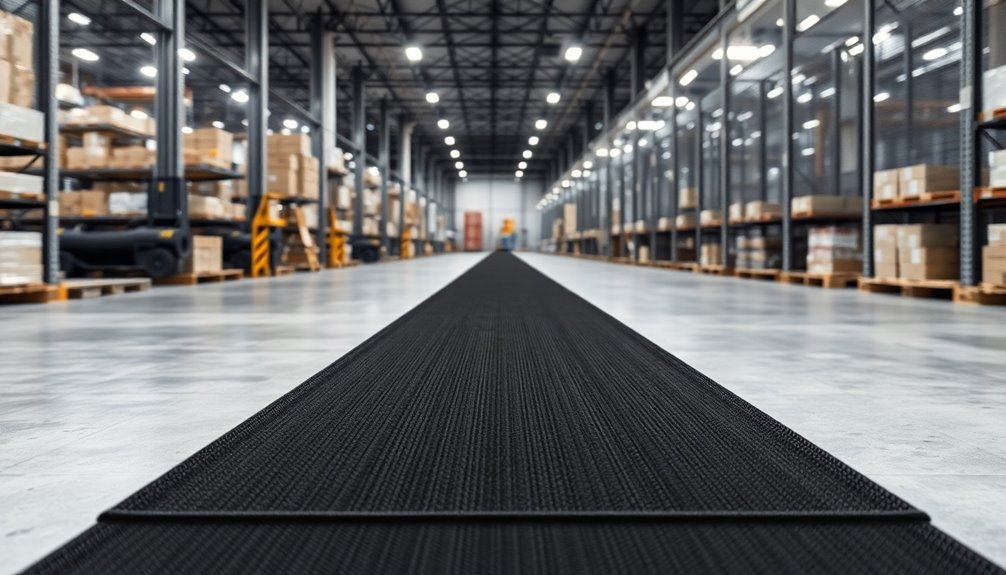



Leave a Reply